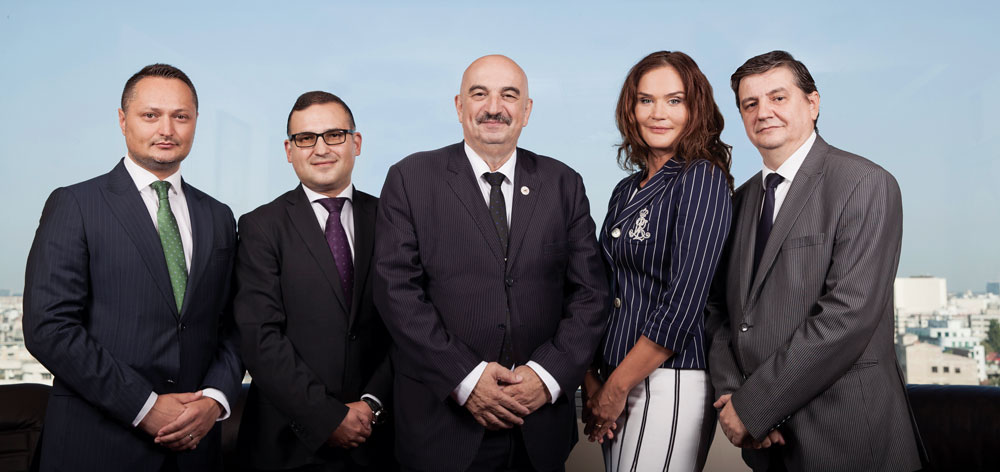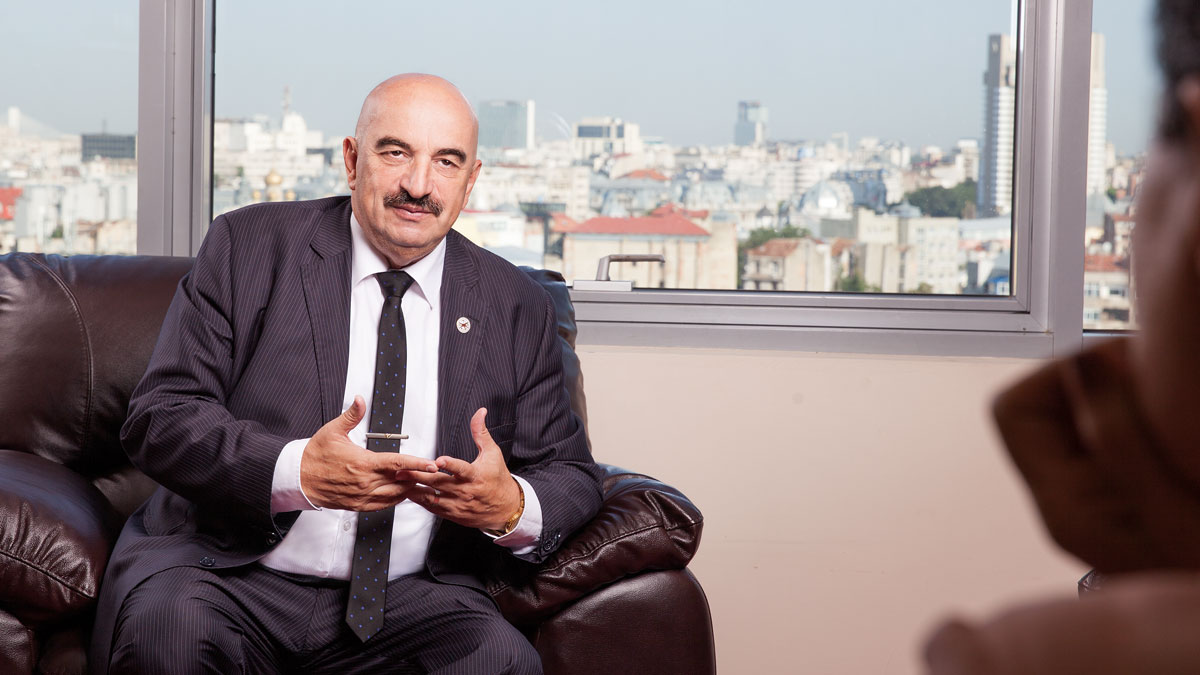Adrian Constantin Rusu: 3 Keys to Transelectrica evolution – Investment-Innovation-Progress
Adrian Constantin Rusu is CEO of the National Power Grid Company Transelectrica (the transmission and system operator in Romania). In an extended discussion with him we covered the importance of the PTG, European projects in which Transelectrica is involved and the company’s development strategy in European context.
Transelectrica manages, operates, maintains, upgrades and develops the transmission network, which includes 81 electric substations, with a capacity of over 38,000 MVA and 8,834.4 kilometres of overhead electric lines of 100/220 kV, 400 kV and 750 kV, managed by eight transmission branches.
The company has recently accepted the upgrade works at the Substation 400/220/110/20 kV Suceava, an important node of the Power Transmission Grid (PTG) ensuring the safe operation of the National Power System (NPS) and connecting the historical provinces of the country.
Dear Mr. Adrian Constantin Rusu, you have a career of almost 40 years in the energy sector and in Transelectrica you have spent more than half of this time. It can be said that this Company represents your life. Since May you have been appointed CEO of Transelectrica. What is your management approach?
Indeed, most of my career has been dedicated to this Company, which, as you say, represents for me more than a job. When we talk about Transelectrica, it must be clear that we are talking about a company of strategic importance providing a public service and I would like to emphasize that the strategic importance of this national company is not limited within the country’s borders, but exceeds them, due to the role that Romania, through Transelectrica, has in the region in terms of energy security. Therefore, the priority objective of this company is to ensure the safety in operation of the power system, and it can only be achieved by permanently making investments and maintaining the facilities. Such a strategy translates in a long term in sustainability and predictability for the Company, shareholders and investors, because we shouldn’t forget that Transelectrica is a company listed on the stock exchange. This is where we start in the management approach, these are the concepts we build on.
It is strategic to develop a vision focused on investments, to substantially improve the amount of investments, to introduce the concept of digitization and channel all our efforts on this direction. Transelectrica has this year a very serious and ambitious investment plan. In H1 2018, we commissioned investments worth RON 166mln and we have major projects in progress and which we will start: closing the 400kV ring, projects of common interest at European level, retrofitting and upgrade of substations.
Transelectrica is a strategic company at national and regional level. What is Transelectrica’s position in this European context?
At European level, the energy sector is in a process of deep transformation. Emphasis is placed on transition from a predominantly national model of evolution and development of the energy sector to an integrated and coordinated development model at European level, that would ensure unitary development at the continental level and also allow for adaptation to national specificities and the pursuit of legitimate interests of European countries.
As an integral part of the European interconnected system, Transelectrica is responsible not only for the functioning of the Romanian power system under the safety and quality parameters and for supply to national consumers, but together with the other transmission and system operators, it has extended its competence and responsibility at European level. We are talking about 36 countries with 532 million consumers.
Transelectrica is a valuable partner in preparing and negotiating legislative packages applicable to the energy sector, being part of the European family, as a member of ENTSO-E (European Network of Transmission System Operators for Electricity).
Transelectrica has been an active partner through its technical and operational expertise as a transmission and system operator both in the process of developing the European network codes within the ENTSO-E structures and in the negotiation stages at European Commission level and through the competent ministry at the European Parliament level.
Transelectrica is a strategic partner in preparing the ENTSO-E 10-year network development plan. Electricity transmission networks play a crucial role in meeting European aspirations, especially in terms of safety of supply to consumers, the formation of a common energy market and the integration of renewable sources.
Within the ENTSO-E, integrated and coordinated planning of pan-European transmission infrastructure development (TYNDP: 10-year network development plan) is carried out, the main corridors and priority projects (list of projects of common interest) are identified and incentive mechanisms are used to accelerate their implementation (e.g. the Connecting Europe Facility – CEF).
Transelectrica develops, at national level, the planning of the development of the Romanian electricity transmission network, taking into account projects of regional and European relevance (e.g. cross-border interconnectivity, RES integration), as well as projects of national relevance (retrofitting, upgrade, replacements of equipment worn physically or morally).
In parallel with the negotiations on the adoption of the energy regulatory framework, a number of projects are being carried out at the level of transmission and system operators, aimed at implementing the European single energy market, implementing European network codes or investigating the specific aspects on challenges of the new legislative package: Clean Energy Package.
The integration of the Romanian electricity market into the European internal market is a major objective of Romania, circumscribed to the strategic objective of creating the European internal energy market, a priority objective for Europe, which requires coherent measures and joint efforts of all the involved entities: competent ministries, regulatory authorities, transmission and system operators, energy exchanges.
In this context, it is important to mention that Romania is at the confluence of the European Central-West (CORE) and South-East (SEE) regions, and due to this position, we aim to become an interregional integration factor, thus contributing to increasing security and sustainability at pan-European level.
Operating since 2014 in the 4M MC coupled market (Romania, Hungary, Slovakia and the Czech Republic), Transelectrica has become a partner in the projects in Eastern-Central-Western European (CORE region), while being active in the Southeast European region, thus expanding its scope of engagement and competence across Europe.
Simultaneously with projects for market coupling and coordinated allocation of cross-border transmission capacity, Transelectrica is part of the development and operationalization of platforms for trans-European trading in balancing energy.
These platforms will contribute to an optimization of the process of balancing the electric power systems at European level, generating economic and social welfare and contributing to increased safety in electricity supply to European consumers.
I would like to highlight what I meant by saying that Transelectrica specialists are very active, being part of many projects at European level involving transmission and system operators. I mention only: TERRE – Trans European Replacement Reserve Exchange (implementing an information platform (LIBRA) dedicated to trading offers for the replacement reserve of the participating electric power systems), MARI – Manually Activated Reserves Initiative (implementing the European balancing platform for trading manual Frequency Restoration Reserves (mFRR)), PICASSO – Platform for the International Coordination of Automated Frequency Restoration and Stable System Operation (implementing a European balancing platform for exchanges between Transmission and System Operators of automatic frequency restoration reserves) and IGCC – International Grid Control Cooperation (Imbalance Netting) (creating a unique European platform for real-time imbalance netting, in order to reduce costs with balancing energy).
We are partners in European innovation research projects such as CROSSBOW, a project that proposes to share resources to promote the cross-border management of renewable energies and storage facilities, allowing greater penetration of renewable energy sources, while reducing the operational costs of the network and improving the economic benefits of RES and storage facilities. This project benefits from European financing of EUR 17mln.
Transelectrica is part of the RESERVE project (Renewables in a Stable Electric Grid), a project aiming to investigate new concepts on technological system services, in conditions of large scale integration of renewable energy sources into electric power systems, and possibilities to use such sources in system balancing.
I would also like to remind you of the project on the submarine cable connection with Turkey, with an essential role in the decongestion of the south-eastern part of Romania, namely the Dobrogea area.
We can see that Romania, through Transelectrica, is an important voice in Europe. How do you estimate energy security in this context?
In European context, as I said we act in two regions: Central Europe and Southern Europe, and this is the most important opportunity we have, in terms of energy security. Therefore, by the fact that we are the border of ENTSO-E, an extremely important role in this context is played by the project of closing the 400-kV ring of Romania.
The European size of Transelectrica is the natural direction of development of the Company in terms of energy security. For this purpose, Transelectrica’s affiliation to the Regional Security Coordination Centre (RSCC) TSCNET Service GmbH was approved in late June under a memorandum adopted by the Romanian Government. Romania was the only country in the CORE region that was not part of the ownership of the Regional Security Coordination Centre TSCNET. Due to its geographical position, Romania, through Transelectrica, is a regional pole of stability in the European electricity transmission system, therefore it is very important to be on an equal footing in this context. Our goal for the following period is not only to maintain this regional role, but to consolidate it. Taking into account its resources, Romania has the right to be a strong voice at European level in terms of energy security. Transelectrica’s entry in TSCNET Services GmbH ownership together with countries such as Germany, Austria, the Czech Republic, Slovenia, Denmark, Croatia, Hungary, Poland, Switzerland, the Netherlands and Slovakia is a step part of a normal and necessary evolution for Romania’s positioning on the European energy map in the context of implementing the new model of the common electricity market, of European network codes and in the perspective of Clean Energy Package.
In the same light of energy security in the region, Transelectrica has been invited to join the ownership of the European Centre for Cross-border Transmission Capacity – Joint Allocation Office (JAO). We are currently in the stage of preparation of this step of Company’s affiliation to JAO.
Transelectrica has the target of increasing the interconnection capacity from 7% of the production capacity currently installed, to 10% in 2020 and 15% in 2030. What is the company’s strategy on these targets?
I would like to highlight that Transelectrica has in progress important investment projects for strengthening cross-border interconnection networks. We have recently inaugurated the 400 kV Resita-Pancevo OHL, achieving interconnection with Serbia, a European project implemented with Romanian companies, which will contribute to strengthening the electric power systems of the two neighbouring states and eliminating the risk of network congestions.
Completing the 400 kV Resita-Pancevo OHL, a total investment of over RON 98mln, will allow for an increase in the transfer capacity between Romania and Serbia and in the entire Central and South-Eastern Europe. But in order to significantly increase the transfer capacity on this relation, it is very important to complete the switch to 400 kV of the Banat Axis, especially of the Anina-Resita section. Works are in progress and we hope that in 2021 we will complete works at the Portile de Fier – Anina – Resita section.
In relation to Hungary, we will complete the 400 kV OHL Oradea–Bekescsaba, a large-scale project blocked in the last 10 years, which could be restarted thanks to a Government Decision adopted in May 2018.
Also, interconnection with the Republic of Moldova is a strategic project for which Transelectrica shows all openness and is carried out under the auspices of the agreements between the two governments, Bucharest and Chisinau.
This entire picture means for Transelectrica continuous evolution, opening new horizons and Romania’s chance to become in the following period an energy hub in South-Eastern Europe. And the key for this evolution of Transelectrica is the triad: INVESTMENT-INNOVATION-PROGRESS.

You have recently completed the upgrade of the 400/220/110/20 kV Substation Suceava. What was the process, what importance does this objective have for the NPS and what amount was allocated for the project?
It’s true, in late July we commissioned the investment under which the 110 and 20 kV voltage levels were upgraded at Suceava substation, which operates on four voltage levels, 400/220/110/20 kV. We are talking about an investment of RON 24mln and works consisted mainly of replacing primary equipment, replacing the existing protection and automation installations with an integrated command and control system, which will lead to higher security in operation, as well as to a decrease in maintenance costs. The 400 and 220 kV substations were upgraded in a first stage, during 2009-2011, within the project ‘Conversion to 400 kV of the axis Gutinas – Bacau Sud – Roman Nord – Suceava within the National Power System’.
With the upgrade of 110 kV and 20 kV levels, the 400/220/110/20 kV Substation Suceava becomes a very important energy node allowing the closure of the 400-kV ring in the northern area, ensuring connection between Moldavia and Transylvania, through the future 400 kV Suceava – Gadalin line. At the same time, conditions are created for this substation to be a connection point for the future interconnection of the power systems of Romania and of the Republic of Moldova, through the 400 kV Suceava-Balti line.
The full upgrade of this substation increases the security of supply to local consumers, but especially it increases the security in operation of the National Power System. Suceava Substation has a crucial role for the northern part of Moldavia, because, besides its strategic position in the National Electric Power System, it ensures electricity supply to Suceava and Botosani counties.
What other upgrade projects do you plan for 2018 and what is the value of investments scheduled for this year?
Currently, we have in progress for upgrade and retrofitting 14 electric substations, we are carrying out projects for the upgrade of overhead lines and projects of common interest.
An investment priority for Transelectrica and a challenge at the same time is the closure of Romania’s 400-kV ring. Completing the Ring, this electricity highway, will increase security in the operation of the NPS, besides fulfilling the obligations undertaken at EU level, and it will also contribute to increasing the regional energy security, as I have already explained. Currently, the 400-kV ring is completed at a rate of around 64%, the rest of around 36% representing segments that are either in work or in various phases of preparation.
Currently, important investment works are being carried out within the Portile de Fier – Resita segment, for closing the 400-kV ring.
Closing the 400-kV ring is fundamental for both the western area, where we will achieve a better interconnection with Europe, and for the eastern area, where there is this congestion of power evacuation from south-eastern Romania, i.e. Dobrogea area.
In short, the segments with the 400-kV ring necessary to be completed are:
- The Banat – Portile de Fier – Arad axis – in various stages of completion, included in the 3rd list of projects of common interest of the European Commission;
- 400 kV OHL Arad – Nadab;
- 400 kV OHL Oradea – Bekescsaba – the section Oradea Sud – Nadab, project unlocked this year;
- 400 kV OHL Gadalin – Suceava – in the design and permitting phase;
- 400 kV OHL Gutinas – Smardan – the application for financing with European structural funds is in preparation.
What is so important about the 400-kV ring?
The main benefits of closing the 400-kV national ring consist of: increasing the security in operation of the National Power System; facilitating electricity transmission from the areas with surplus production to consumption areas; achieving an economic regime of operation of the Power Grid; as well as increasing the possibilities of electricity export to the Energy Systems of neighbouring countries.
Strengthening Romania’s interconnection capacity will facilitate the export of energy produced, in certain periods, by wind and solar power plants within the NPS, in excess compared to domestic demand.
Another strategic direction regarding the transmission network and ensuring the security in operation of the National Power System is related to the development of the Bucharest metropolitan power network. Following the specific conditions of economic development, in the Bucharest metropolitan area there is an increase in electricity consumption higher than the average per country. This trend is estimated to be maintained for the following period. For electricity supply in conditions of safety, over a long term, to Bucharest municipality, this growth trend of consumption must be reflected directly proportionally in measures to strengthen electricity transmission and distribution networks. At Transelectrica’s level, extensive analyses have been conducted, resulting in the need to build two new electric substations of 400/110 kV. In the same context, it is necessary to implement a 400-kV ring of the Capital.
What investment projects of common interest (PCI) of Transelectrica are currently approved at European level and what are the perspectives for the following period?
In the line of European cooperation that I have told you about in detail, Transelectrica has six projects of common interest worth more than RON 1 billion, within the ‘Black Sea Corridor’ and ‘Mid Continental East Corridor’ clusters, part of the priority electricity corridor ‘North-south electricity interconnections in Central Eastern and South Eastern Europe’ (NSI East Electricity).
The ‘Black Sea Corridor’ cluster has the role of consolidating the electricity transmission corridor along the Black Sea coast (Romania-Bulgaria) and between the coast and the rest of Europe and Turkey. The ‘Mid Continental East Corridor’ cluster leads to a higher exchange capacity on the borders between Romania – Hungary – Serbia; boosts the European north-south corridor from north-eastern Europe to south-eastern Europe through Romania, allowing a stronger integration of markets and increasing the security of supply in South-Eastern Europe.
The six investment projects of Transelectrica included on the list of European Commission’s projects of common interest are:
- 400 kV overhead line (OHL) Cernavoda – Stalpu, part of the Cluster Bulgaria – Romania capacity increase (‘Black Sea Corridor’);
- 400 kV overhead line (OHL) Gutinas – Smardan, part of the Cluster Bulgaria – Romania capacity increase (‘Black Sea Corridor’);
- 400 kV overhead line (OHL) Suceava – Gadalin, part of the Cluster Bulgaria – Romania capacity increase (‘Black Sea Corridor’);
- Interconnection between Resita (RO) and Pancevo (RS) – part of the Cluster Romania – Serbia between Resita and Pancevo (‘Mid Continental East Corridor’);
- Internal line between Portile de Fier and Resita (RO) – part of the Cluster Romania – Serbia between Resita and Pancevo (‘Mid Continental East Corridor’);
- Internal line between Resita and Timisoara/Sacalaz (RO) – part of the Cluster Romania – Serbia between Resita and Pancevo (‘Mid Continental East Corridor’).
We have already obtained co-funding of EUR 27mln for building the 400 kV OHL Cernavoda – Stalpu. For starting works within this project we also received in May the first instalment worth EUR 2.2mln. The Cernavoda – Stalpu line will contribute to increasing the interconnection capacity between Romania and Bulgaria and to integrating wind energy from Dobrogea area, which is a major challenge for the power system of Romania in the current conditions, but also in the perspective of developing wind capacities in the area. The new 400 kV line will have a length of around 160 kilometres, and for its commissioning it is necessary to build the Substation 400 kV Stalpu and extend the Cernavoda and Gura Ialomitei substations. I hope that in the following period we will also obtain funding for OHL Gutinas – Smardan.
The main investments completed by Transelectrica in H1
- 400 kV OHL interconnecting Resita (Romania) – Pancevo (Serbia)
- Upgrading the Cluj Est 400/110/10 kV electric substation
- Replacing AT (autotransformers) and trafo (transformers) in substations – stage 2 – Batch I – Replacing AT1 – 200 MVA in the Craiova Nord 220/110 kV substation
- Replacing AT and trafo in substations – stage 2 – Batch I – Replacing AT2 – 200 MVA in the Arefu 220/110 kV substation
- Upgrade of the command-control-protection system of the Sardanesti 220/110/20 kV substation
- Upgrade of the Suceava 110 kV and 20 kV substation – Stage II: 110 kV cells, AT – FAI 220 kV cell, 20 kV substation
- Installing optical fibre on the Fundeni – Brazi Vest 220 kV OHL – Batch 1
- Connection of Turnu Magurele, Mostistea, Stalpu, Teleajen substations to the optical fibre network of CNTEE Transelectrica SA – Batch 2







